SMART – The Largest Prospective
NIPT Study1-3
The SMART study enrolled more than 20,000 patients at 21 medical centers globally and is the largest prospective non-invasive prenatal testing (NIPT) study ever performed. The study evaluated the performance of SNP-based NIPT (Panorama®) in a real-world population. All results included in the analysis were validated with genetic confirmation.
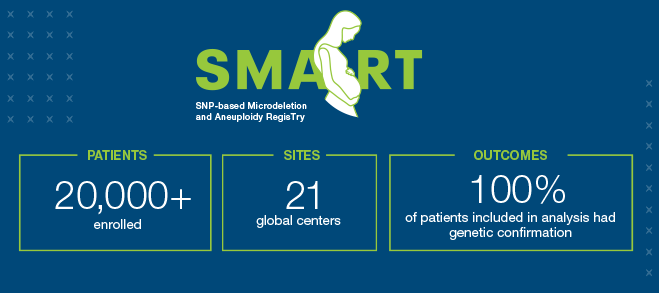
Results for 22q11.2 deletion and common trisomy screening:
Now published in the American Journal of Obstetrics & Gynecology
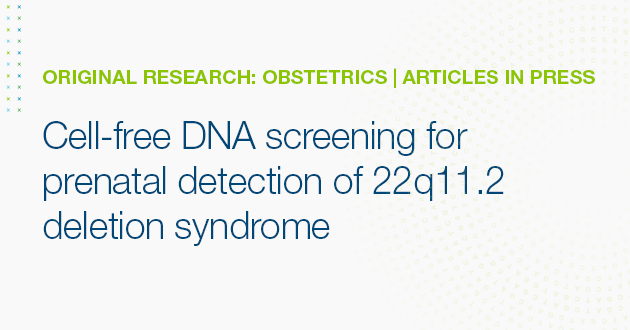
Authors: Pe’er Dar, MD | Bo Jacobsson, MD, PhD | Rebecca Clifton, PhD | Charlly Kao, PhD | Hakon Hakonarson, MD, PhD | Mary E. Norton, MD
Open Access: Published: January 13, 2022
- 22q11.2 deletion syndrome (22q11.2DS) had a higher-than-expected prevalence of 1/1,524 pregnancies in this cohort. This is comparable to other conditions broadly recommended for routine screening, such as cystic fibrosis (~1 in 2,500).1,4,5
- Panorama was able to detect all cases of the most common (2.5-3Mb) 22q11.2 deletion, and 83% of all 22q11.2 deletions (0.5Mb+).1
- Panorama’s false positive rate was low, 0.05%, resulting in a positive predictive value (PPV) of 53% or 1 in 2.1
- None of the patients with a pregnancy affected by 22q11.2DS had an abnormal first trimester ultrasound, highlighting the unique potential of NIPT to add valuable information early in pregnancy.1
Panorama 22q11.2DS screening is ordered by clinicians for approximately 800,000 patients per year.
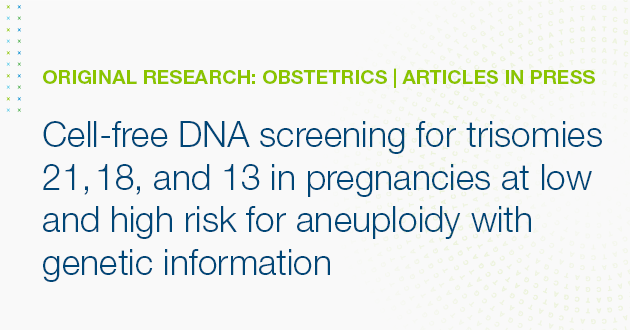
Authors: Pe’er Dar, MD | Bo Jacobsson, MD, PhD | Cora MacPherson, PhD | Charlly Kao, PhD | Hakon Hakonarson, MD, PhD | Mary E. Norton, MD
Open Access: Published: January 24, 2022
- Panorama demonstrated 99% sensitivity and >99.95% specificity for trisomy 21 in a real-world setting, consistent with previously published studies.2,7
- Panorama had a positive predictive value (PPV) of 95% for trisomy 21, which compares favorably with the PPV of 3-4% with maternal serum screening.2,8
- The latest version of Panorama (Panorama AI) maintained high sensitivity, detected additional cases of common aneuploidies, and significantly lowered the “no-call” rate to 1.4% and to 0.5% after one redraw.2
- SMART studied Panorama’s performance in a general population cohort with strong representation from average-risk patients.
- 73% of patients in the analysis were considered at low-risk for aneuploidy prior to screening.2
22q11.2 DS prevalence compared to commonly screened conditions
22q11.2DS is more common than cystic fibrosis and spinal muscular atrophy.4,5,6 It can affect any pregnancy and early detection with ultrasound is limited.1 Panorama offers non-invasive, highly accurate screening to enable early detection.1
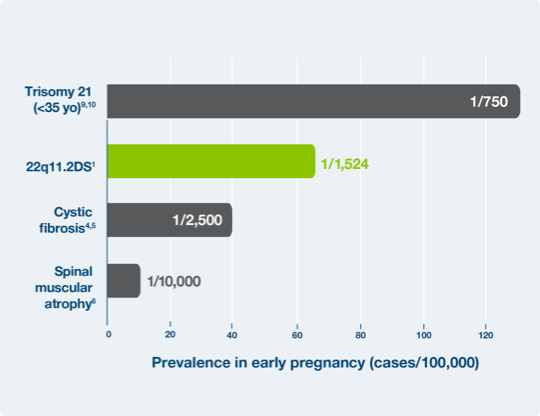

“Prompt diagnosis can play an important role in improving the quality of life for individuals affected by 22q11.2 deletion syndrome. The 22q11.2 community therefore supports early identification including via prenatal and neonatal screening. Importantly, prenatal suspicion of 22q11.2 deletion syndrome allows for evaluation, confirmatory testing, and delivery at high-level healthcare facilities where neonates have access to potentially life-saving interventions including cardiac surgery, as well as treatment for other key features such as low calcium, immune deficiency, feeding, swallowing and breathing issues, all with the goal of optimizing long-term outcome while obviating the protracted diagnostic odyssey frequently traversed by families.” 11,12,13
Watch a short overview video on the SMART study
High accuracy. Lower “no-calls.”
In the SMART study, the latest version of Panorama (Panorama AI) maintained the high accuracy of Panorama while significantly lowering test “no-call” rates.2
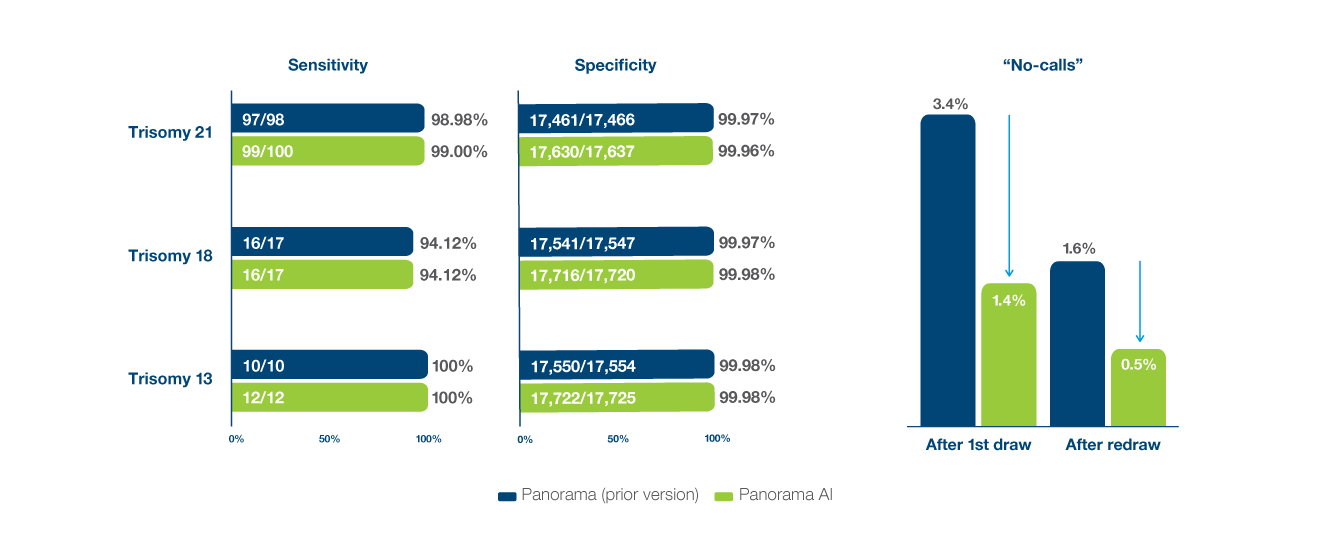
Questions about Panorama?
Submit your inquiries here
1Dar et al. Am J Obstet Gynecol. Epub prior to publication.https://doi.org/10.1016/j.ajog.2022.01.002
2Dar et al.Am J Obstet Gynecol. Epub prior to publication. https://doi.org/10.1016/j.ajog.2022.01.019
3Norton et al. Perinatal and genetic outcomes associated with no call cfDNA results in 18,497 pregnancies. Society of Maternal-Fetal Medicine, SMFM. Virtual Meeting. Oral Presentation. Jan 25-30, 2021.
4Hamosh et al. J Pediatr. 1998;132(2):255-259.
5O’Sullivan. Lancet. 2009;373(9678):1891-1904.
6Prior et al. Spinal muscular atrophy. In: Adam et al, eds GeneReviews. February 24, 2000. Updated December 3, 2020.
7Ryan et al. Fetal Diagn Ther. 2016;40(3):219-223.
8Norton et al. N Engl J Med. 2015;372(17):1589-1597.
9UpToDate. Maternal age-related risk for common fetal trisomies across pregnancy. Accessed Jan 20 2022. https://www.uptodate.com/contents/image?imageKey=OBGYN%2F75423
10Centers for Disease Control and Prevention. National Vital Statistics Reports, Vol. 70, No. 2, March 23, 2021.
11Bassett et al. J Pediatr. 2011;159(2): 332–339.
12Cheung et al. Genet Med. 2014;16(1):40-44.
13Grand et al. Am J Med Genet A. 2018;176(10):2167-2171.